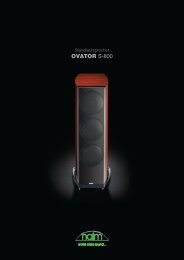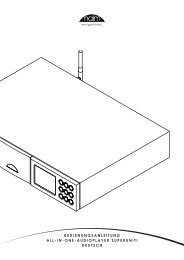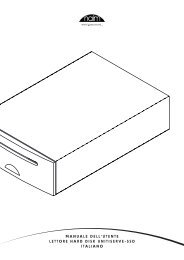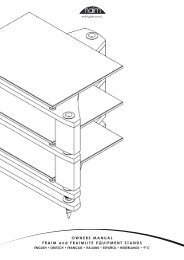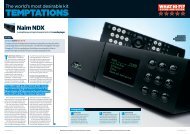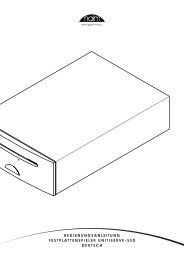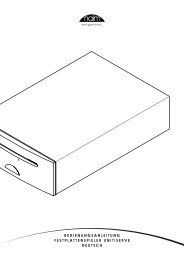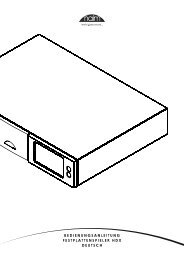Download PDF - Naim Audio
Download PDF - Naim Audio
Download PDF - Naim Audio
Create successful ePaper yourself
Turn your PDF publications into a flip-book with our unique Google optimized e-Paper software.
<strong>Naim</strong> and address<br />
A big integrated amp was an obvious gap in <strong>Naim</strong>’s portfolio. The SuperNait addresses that beautifully<br />
Product <strong>Naim</strong> SuperNait<br />
tyPe Integrated stereo amplifier<br />
Price £2,350<br />
Key FeatureS Size (WxHxD): 43.2x8.7x31.4cm<br />
P Weight: 14.8kg P Inputs: six analogue, five digital,<br />
power supply input, MP3 player mini-jack, headphone<br />
minijack, power amp inputs P Outputs: two tape,<br />
loudspeaker terminals, preamp outputs P Power output:<br />
80 watts per channel P On-board DAC<br />
contact Z 01722 426600 q www.naim-audio.com<br />
If you happen to be an aspiring <strong>Naim</strong><br />
owner but don’t relish the thought of<br />
accommodating a multitude of boxes and<br />
the attendant wiring, the SuperNait might just<br />
represent your ideal choice of amplifier. This<br />
new top-end integrated model combines all<br />
the typical attributes of the company’s<br />
electronics – both the distinctive sonic<br />
performance and the upgradeability and<br />
versatility – with the convenience of being a<br />
44 HI-FI CHOICE june 2007<br />
neat, single-box design that would be easily<br />
incorporated into any home.<br />
A quick read of its specifications will<br />
convince you that it has all the up-to-date<br />
technology that one might reasonably require<br />
nowadays. There are integral digital inputs<br />
and re-clocking conversion, an iPod socket, a<br />
headphone jack, further socketry to enable it<br />
to act either as a preamplifier or a power<br />
amplifier in a bi-amplified system, remote<br />
control and ‘intelligent home’ connectivity,<br />
while its sound should easily convince all but<br />
the most musically illiterate of its worth.<br />
The latter point is something to which we<br />
will return in detail later, but for the moment<br />
we will say that the SuperNait’s musical<br />
performance is utterly amazing. In hi-fi terms, it<br />
is exemplary; but in musical terms, the way in<br />
which it reproduces recordings is beyond the<br />
wildest imaginings of someone (like me) who<br />
has been using <strong>Naim</strong>’s top-of-the-range pre and<br />
power amplifiers for more than two decades.<br />
The SuperNait, it should be understood, slots<br />
into <strong>Naim</strong>’s range at the ‘reference’ end of the<br />
spectrum. It is not a 5-series component. Not<br />
that there’s anything wrong with the 5-series,<br />
but the all-in-one nature and facilities of the<br />
SuperNait might make some people regard it<br />
as some sort of ‘<strong>Naim</strong>-lite’ product, despite its<br />
£2,350 price tag. Believe us, it most definitely<br />
is not watered down in any respect. As <strong>Naim</strong>’s<br />
sales manager, Doug Graham said: “This is a<br />
serious addition to the <strong>Naim</strong> range; one that<br />
will connect you with the music and the<br />
(increasingly important) boy’s toys.” Listening<br />
to it in my own system has utterly convinced<br />
me that he meant what he said.<br />
First, let’s get the boring mechanical details<br />
out of the way: the SuperNait offers 80 watts<br />
per channel and 400VA output for transients<br />
thanks to the expected, over-engineered,<br />
dedicated power supplies that <strong>Naim</strong> always<br />
puts into its designs. Note that this is not a<br />
switching power supply, but a ‘proper’,<br />
meat-eating, bourbon-drinking, toroidal<br />
transformer with seven discrete windings.<br />
Inputs include six of the analogue variety<br />
and five digital (two coaxial and three optical,<br />
including a combination mini-jack/mini-Toslink<br />
connector with auto-switching on the front<br />
panel). The digital board powers down when<br />
an analogue input is selected, to clean up the<br />
electrical environment and to eliminate any<br />
audiophile paranoia.<br />
Those not wishing to stick with single-box<br />
elegance can add external power supplies to<br />
the unit – Flat-Cap, Hi-Cap or Super-Cap – or<br />
can even combine the SuperNait with a<br />
secondary power amplifier to bi-amplify<br />
suitable speakers.<br />
The preamplifier section, which was derived<br />
from the high-end NAC 282 design, offers<br />
separate record and listen selectors on the<br />
front panel, and around at the back, an RS232<br />
port for custom installation applications and a<br />
subwoofer output, which, given my<br />
experiences using the SuperNait, would seem<br />
a tad superfluous.<br />
Before describing how the SuperNait sounds,<br />
it’s worth mentioning that the amplifier is<br />
built into <strong>Naim</strong>’s usual, bomb-proof, triptych<br />
aluminium casework as used in the Reference<br />
series models and uses multi-layer PCBs. As<br />
usual, the inputs are the preferred DIN types<br />
but these are duplicated with RCA phono<br />
connections for the benefit of those who have<br />
yet to see the light, as well as those who enjoy<br />
playing with trick cables.<br />
Because of the tight deadlines involved in<br />
this article, <strong>Naim</strong> rushed one of the first<br />
SuperNaits that it finished round to us on the<br />
same day that Neat delivered a pair of the<br />
Motive 1 loudspeakers. You might imagine<br />
that two new products (new to me, at least)<br />
would not be a wise pairing but we decided to<br />
hook them both up for a listen, and to give<br />
them both a thorough, simultaneous<br />
warm-up. Much to our surprise and delight,<br />
this turned out to be a marriage made in<br />
heaven. Each product gelled with the other to<br />
form what proved to be an intensely satisfying<br />
and dynamic musical joint venture. We used a<br />
variety of analogue and digital sources with<br />
this combination including CD players from<br />
Saxon and Roksan, a Cambridge <strong>Audio</strong> Azur<br />
<strong>Naim</strong> SuperNait integrated amplifier [ Review ]<br />
“Note that this is not a switching power<br />
supply, but a ‘proper’ meat-eating,<br />
bourbon-drinking toroidal transformer.”<br />
640H music server, an Apple Mac Pro laptop,<br />
and, as the final arbiter, my own <strong>Naim</strong> CDS<br />
CD player. Cables were a mix of <strong>Naim</strong>, Chord<br />
Company and various manufacturers’ logo-free<br />
interconnects, and Chord Company Signature<br />
loudspeaker cables.<br />
Sound Quality<br />
We mentioned the SuperNait’s musical<br />
performance a little earlier in this review and<br />
it is in this respect that the design truly stands<br />
way above most other integrated amplifiers<br />
we have heard – and a great many pre/power<br />
combinations, too. It does all the hi-fi stuff<br />
very well, of course, but it’s the way it puts<br />
music together that really makes it shine. This<br />
is a concept that seems lost on many listeners,<br />
not to mention some reviewers, but which, for<br />
me, has always been <strong>Naim</strong> equipment’s<br />
greatest strength. It’s a hard concept to<br />
explain but I’ll do my best: we sat listening to<br />
a selection of CDs recorded by Telecaster P<br />
june 2007 HI-FI CHOICE 45
Q&a<br />
We spoke to Doug Graham, <strong>Naim</strong><br />
<strong>Audio</strong>’s sales manager, about the<br />
SuperNait, and precisely where it<br />
fits in the <strong>Naim</strong> pantheon<br />
HFc This new integrated seems<br />
a radical departure from its<br />
predecessors. Is it?<br />
dG The earlier Naits (shorthand for <strong>Naim</strong> <strong>Audio</strong><br />
integrated) were meant as entry-level introductions<br />
to our brand. The new amplifier reflects how an<br />
increasing number of people now live and their<br />
connectivity requirements. The ability to re-clock<br />
and convert digital info streams from various<br />
sources properly is indeed radical for a Nait.<br />
The SuperNait seemed discriminating about<br />
sources. Is that a good thing?<br />
Our starting point for this project was obtaining<br />
great performance out of a single box. The<br />
analogue stuff came first, which meant a lot of<br />
work and know-how went into the preamp section.<br />
It had to let you know what was being fed into it<br />
and had to be of sufficient quality to respond to<br />
the power supply upgrade options that we provide.<br />
Did implementing the on-board DAC involve a<br />
great deal of work?<br />
We knew the DAC chipset well from our work on<br />
our DVD5, so we were confident that, used in this<br />
application with our own de-jitter circuit, it would<br />
yield great performance. Managing the power<br />
supply to the DAC was very important as was the<br />
software implementation. DACs are much more<br />
complicated to make perform well than most<br />
people (including other manufacturers) think.<br />
Can you connect a turntable to the SuperNait?<br />
It has an ‘Aux 2’ socket that can power a Stageline<br />
or a Prefix phono stage.<br />
What speakers, other than your own, does the<br />
SuperNait work successfully with?<br />
We’ve just returned from a show where one of our<br />
dealers was using the new Kudos brand: the C10<br />
and C20 seemed to be a very good match. Other<br />
than that, Neat speakers have shown some<br />
impressive synergy. The SuperNait is very capable<br />
with difficult speaker loads: you might be surprised<br />
by what it ends up driving.<br />
Q maestro, Steve Cropper and blues ace,<br />
Robert Ward. Neither of these guys is an<br />
outwardly impressive player – certainly not in<br />
terms of today’s million-notes-a-minute<br />
shredder guitarists, yet the SuperNait easily<br />
revealed that it was their phrasing, tone, and<br />
the choice of notes they played as well as<br />
those they left out that marked them out as<br />
being a cut above journeyman players.<br />
This wasn’t just the usual Pace, Rhythm and<br />
Timing thing: certainly all the temporal clues<br />
were present and correct but the SuperNait<br />
and the Neats seemed able to dig deeper still<br />
into the music and get to those telling, often<br />
quite deeply submerged, nuances with<br />
immeasurable dexterity. For example, several<br />
times we found ourselves involuntarily<br />
smiling as Vernon Reid ripped through We<br />
People Who Are Darker Than Blue from the<br />
Curtis Mayfield tribute album People Get<br />
Ready, awe-struck by his harmonic sensitivity<br />
and the subtle detuning he uses to great<br />
effect on the track.<br />
It’s not that other hi-fi amplifiers and<br />
speakers don’t render such information but<br />
simply that the SuperNait portrays it in such a<br />
way that one can’t easily ignore it, or its<br />
influence on the music as a whole. The<br />
SuperNait and Neat Motives are an ideal<br />
coupling for anyone who wants to transcribe<br />
songs to write guitar or bass tablature, for<br />
example. Was that a quarter-note bend or a<br />
half note? The SuperNait will provide the<br />
answer with clarity and gusto.<br />
In a recent conversation with one of the<br />
UK’s most influential loudspeaker designers<br />
and semi-pro jazz players, I was told that few<br />
systems truly recreate bass with any real<br />
semblance of pitch. He had obviously not<br />
heard this system, which seemed uncannily<br />
able to convey low frequencies with vivid<br />
realism and conviction. We don’t mean<br />
make-you-soil-your-underwear, AV subwoofer<br />
style bass, but really powerful lows replete<br />
with note-shape, intonation, tone and attack/<br />
delay envelopes by the truckload. The Motive<br />
1s clearly played a valuable role in this<br />
instance, but they could only do what the<br />
amplifier was instructing them to do and the<br />
SuperNait was gripping them in a vice-like<br />
fashion. And this was at levels varying from a<br />
mere whisper to a full-on ear-bleeding assault.<br />
The amplifier’s exemplary timing ensured that<br />
despite the metronomic regularity and<br />
precision of low frequencies, the idiosyncrasies<br />
of whoever was playing were still allowed<br />
through to full effect.<br />
Earlier we touched on the subject of cables,<br />
with which the SuperNait, with its copious<br />
connections, lends itself to experimentation.<br />
And experiment we did, with both sources and<br />
cables. The amplifier proved to be especially<br />
open and revealing of sources. The <strong>Naim</strong> CDS<br />
quickly established itself as the source of<br />
choice. The Hi-Line cable then proved why it<br />
costs as much as it does by vaingloriously<br />
trouncing a selection of other high-end and<br />
more lowly interconnects. Again, this wasn’t<br />
an ‘Oh, the treble sounds sweeter’ type of hi-fi<br />
Detail<br />
Digital circuitry<br />
with 24-bit,<br />
192kHz DAC<br />
Power amp<br />
section (80W<br />
per channel<br />
into 8 ohms)<br />
Preamp section<br />
based on<br />
reference series<br />
Motorised<br />
volume and<br />
balance pots<br />
“It is a wonderfully cohesive-sounding<br />
amplifier and it has no problems knitting<br />
together diverse musical strands.”<br />
decision. It was far more relevant than that:<br />
while Aimee Mann sounded pleasant but<br />
nothing special as a vocalist on her Whatever<br />
CD through regular cables, her voice sounded<br />
quite magical through the Hi-Line; similarly,<br />
Lightning Hopkins’ guitar work took on an<br />
even more meaningful and expressive<br />
demeanour through the better cable. We’ve<br />
tried this comparison through many systems<br />
and never before heard results so clearly<br />
night-and-day. The same was true when<br />
swapping a supplied component digital cable<br />
with the Chord Company’s Optichord Toslink<br />
lead. The differences in the performance and<br />
presentation were truly dramatic. And we had<br />
the benefit of a very experienced listener –<br />
and equally cynical friend – providing a<br />
reality-check as we switched leads.<br />
Comparing the SuperNait with a NAC 122X<br />
and NAP 200 combination was equally<br />
enlightening, with the integrated model more<br />
than holding its own against the pre/power<br />
set-up. We dare suggest that anyone who was<br />
set on having one box instead of more in their<br />
living room would scarcely determine any<br />
musical difference between the presentation<br />
of the two systems. One listener preferred the<br />
SuperNait, feeling its view of music sounded<br />
more clearly etched and decisive. And, on<br />
several tracks, we felt inclined to agree with<br />
him. Certainly it is a wonderfully cohesive<br />
sounding amplifier and has no problems<br />
knitting together diverse musical strands: no<br />
better did it display this facility than with<br />
tracks from Tower Of Power’s Soul Vaccination<br />
<strong>Naim</strong> SuperNait integrated amplifier [ Review ]<br />
11 separate<br />
power<br />
supply caps<br />
Custom-made<br />
heatsink<br />
500VA<br />
toroidal<br />
transformer<br />
CD, where the steamroller bass thundered<br />
along relentlessly, with outstanding fluidity<br />
and clearly defined pitch. All the while, the<br />
staccato horns and muted guitar chops<br />
punctuated its flow with their relevant, but<br />
delightfully incisive and coherent interjections.<br />
And that appears to be the <strong>Naim</strong><br />
SuperNait’s forte: pair it with a good source,<br />
capable loudspeakers, and don’t scrimp on the<br />
cables, and it will nail a surprising smile to<br />
your face permanently, irrespective of your<br />
musical inclinations. HFc<br />
Malcolm Steward<br />
R Pro<br />
Musically riveting. High-end<br />
<strong>Naim</strong> quality meets the<br />
plug-and-play generation.<br />
Not simply a BigNait, this one<br />
takes on <strong>Naim</strong>’s own pre/<br />
power combos in a fair fight...<br />
and the result’s a draw.<br />
S con<br />
Its openness doesn’t always<br />
favour lesser quality source<br />
components, and even<br />
interconnect cables.<br />
concluSion<br />
A superb high-end introduction to the <strong>Naim</strong> sound that might<br />
just satisfy you for a life-time. The SuperNait combines a truly<br />
engrossing musical performance with single-box simplicity and<br />
forward-thinking connectivity. We love it!<br />
overall Score 92%<br />
>><br />
46 HI-FI CHOICE june 2007 june 2007 HI-FI CHOICE 47<br />
verdict<br />
Sound >> 93%<br />
FeatureS >> 90%<br />
build >> 90%<br />
value >> 92%



